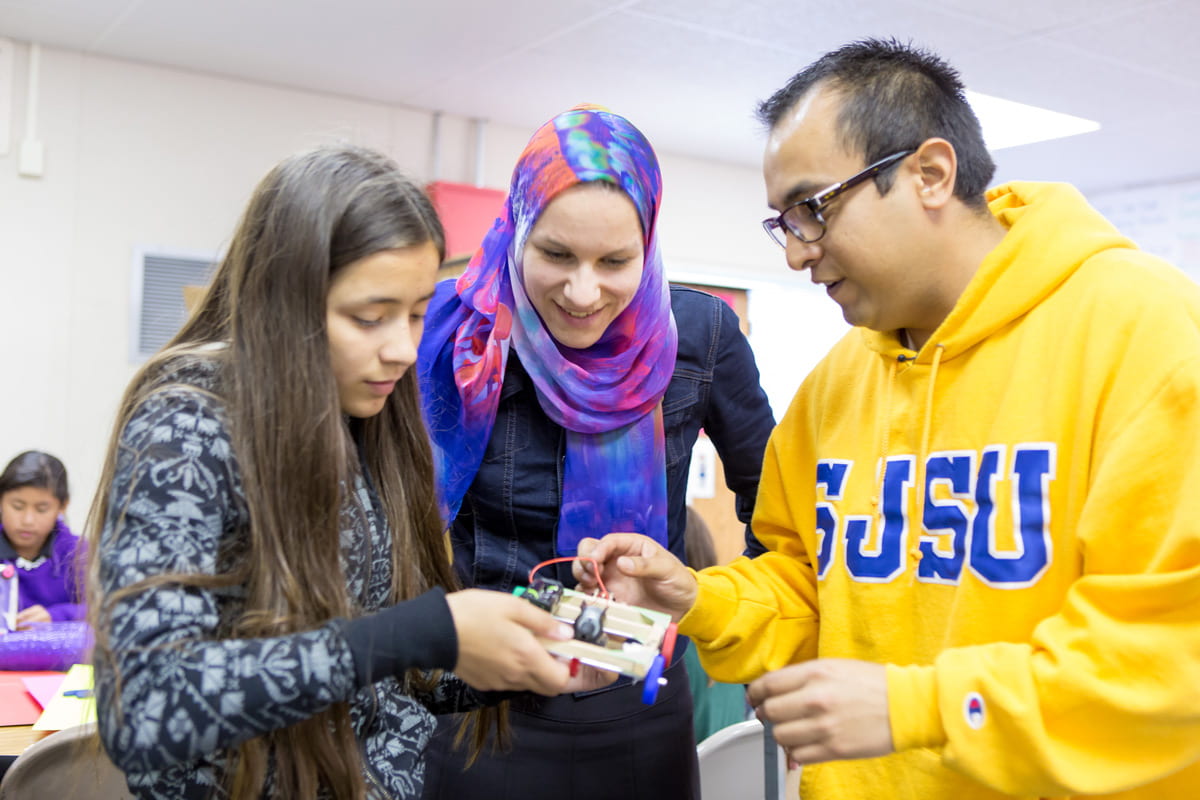The National Science Foundation (NSF) has recently awarded a $1.69 million grant to San José State’s faculty members for a research proposal titled “Transforming Undergraduate Teaching and Learning Through Culturally Sustaining, Active and Asset-Based Approaches to Introductory Science Courses” that aims to increase diversity, inclusion and retention in STEM.
Over the course of the next five years, the STEM research team led by Cassandra Paul, associate professor of physics and astronomy, and science education, will be employing innovative instructional approaches to reduce attrition rates in introductory STEM courses.
“The goal of this grant is to increase student success and graduation rates for undergraduate students and, more specifically, for Latinx and other students belonging to regional, racial and ethnic minority groups,” said Paul, principal investigator of the project.
Historically, the attrition rates in STEM courses are highest during the first two years of college, especially among Latinx and underrepresented minority students. “We want to make sure that we’re listening to what the students are bringing with them to SJSU, and engaging with them more actively,” said Paul.
According to Pamela Stacks, associate vice president of research, the beauty of the kind of research that Paul and her team are doing is that it not only tells us about Latinx students but provides insights into all students.
“Getting this grant opportunity means that STEM faculty members can now be more collaborative and informed about connections between different STEM disciplines, and also they’ll be able to identify issues students are struggling with,” said Stacks. Stacks added, “eventually when the research gets published, it will impact a much bigger audience and, in the process, elevate our whole institution.”
Co-PIs Tammie Visintainer, assistant professor of teacher education and science education, and Marcos Pizzaro, associate dean of the Lurie College of Education, have lent their expertise in educational equity to the project. Their research and service work informs the culturally sustaining and asset-based approach of this work.
“This grant is truly unique because it explores introductory science instruction as something that needs to be more inclusive and leverage the diverse resources that Latinx and other students of color bring with them—which has consistently been ignored and/or not celebrated in institutions of higher education,” said Visintainer, who played a significant role in writing the grant.
Part of the impetus for the grant, according to Paul, came about during informal meetings with STEM faculty members Resa Kelly, professor of chemistry and science education, and Katherine Wilkinson, associate professor of biological sciences, who are also co-PIs for the project. The idea to better align and link content across different courses like biology, chemistry and physics motivated the team to create a cohesive experience for students entering STEM majors.
The novel part, said Visintainer, “is how faculty “see” students of color and how this shapes their instruction.”
“The innovative approach of this grant is that we are specifically seeking to identify the cultural wealth, assets, and strengths that uniquely position Latinx students to thrive and succeed in STEM disciplines – and tapping into those,” said Visintainer.
The entire first year of the five-year grant will be spent on collecting data, talking to students and interviewing them, and also learning more about their experiences.
“The first year is really about getting a better understanding of what the students’ STEM experience is at SJSU in order to be better informed for the next stages of the grant,” Paul said. Subsequently, the team has plans to develop new faculty learning communities that will engage with the data, identify different aspects of the curriculum, and then adapt and align content to ensure a coherent experience for the students.
Since it’s a grant with a particular focus on Hispanic-Serving Institutions (HSI), Tammie Visintainer said, “we are going to focus on that population while also transforming science and undergraduate education for everybody.”
Stacks agrees that gender, race and ethnicity elements are crucial in STEM, she thinks that diversity of thought is what the community should strive for. “What’s more powerful as we become more inclusive is that we expand the intellectual elements, and then we make possible solutions to how we approach things,” said Stacks.
Stacks said that Paul has implemented a radical reform process in her physics classes since joining SJSU in 2012. Besides improvising on teaching style and technique, Paul is also experimenting with grade scales that are different from the traditional percent scale for assessing students. “We saw our fail rates go way down. And so our students are much more successful in the course,” said Paul. “We’ve also started group quizzes and group portions of the finals. So every aspect of the class has a community element to it,” she added.
“In this moment in history, the most exciting part of this grant is that it creates space for a true reimagining of undergraduate STEM education,” said Visintainer.
The other important aspect of the grant is that the research faculty members were supported for preliminary research by CSU STEM-NET (a system-wide research affinity group) that promotes research, community building and innovative educational ideas across the CSU university system.

